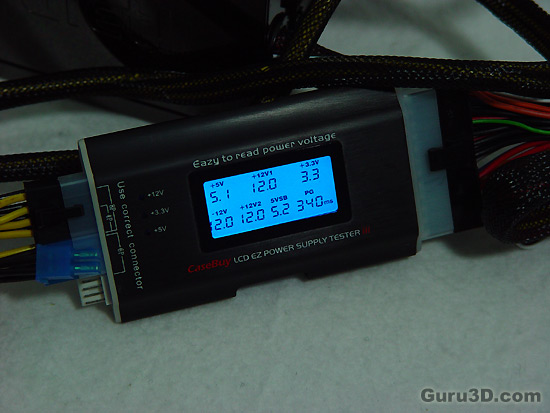The Test
The Test
Unless you have seriously professional equipment worth thousands of EURO's, it's very hard to test, and most of all stress a PSU. Firstly we do a quick test with this nifty new gadget I have been testing. With a power supply tester I'll quickly check if the rails are all working properly and what amount of voltage they are delivering without a PC connected to it.
This is just a test to see if the PSU is functional and working properly before we connect it to equipment worth a stack load of money.
Okay, so we can instantaneously see that all primary voltage rails are working properly. Voltages seem to be precisely what they need to be, and fall well within ATX specifications. So this is looking good. This however is not an objective enough tool to measure voltage at all.

For more precise measurements we'll test with a multi-meter. For those that are wondering what the PG delay being displayed on the screen is, here we go: Power Good (PG) Delay and Off Delay: It takes a power supply at least 100ms to completely power up before it can offer the proper DC voltages to the computer. The computer will not attempt to turn on until the power supply is finished powering up and sends a Power Good (PG) signal to the motherboard via a PG terminal. On power up the Power Good (PG) terminal is polled for a brief period before the PC turns on to check the status of the power supply. Only after the +5V and +3.3V rails are above threshold does the PG signal go "high." The PG signal stays on until the PC is ready to power off. The period of delay between switching on the PS and the actual application of power is the PG delay. Typical values are 100-350ms. The PG delay of the power supply should roughly match the PG delay specification of the motherboard or power on problems may occur.
So this is within specifications. Let's do a real-world test.
Load testing the PSU
As you can see, we had a bit of a challenge at hand. I mean without professional Chroma load testers it's pretty hard to stress a 700 Watt power supply.
So here's what we did. I decided to take a power hungry nForce 790i SLI motherboard. Then took 2x GTX 295 (four GPUs) for maximum power consumption. Here's where I ended up using all Molex connectors (!)
I wanted to add another GeForce GTX 275 purely for PhysX, but I did not have any power connectors left. Then we took a power hungry QX9770 processor and overclocked it towards 3600 MHz. Then we overclocked our memory as well.
These are the components used:
- nForce 790i motherboard (has high power consumption
- Core 2 Quad QX 9770 Processor (overclocked to 3.6 GHz)
- 2x GeForce GTX 295 primary (4 GPUs)
- 3 GB Memory DDR3 @ 1600 MHz
- Optical Drive x1
- HDD x1
Normally, we'd reach 700 Watt power consumption. But with power supplies getting more and more efficient these days .. that proofs to be a very hard task to accomplish. We gave it our best though. Let's have a look at the test results.
So here's where we start a selection of gaming tests well balanced for optimal CPU (multi-core) and GPU performance. We take a multi-meter and tap critical points during system under load and when in idle. We then observe the voltage fluctuation. A lot of de/increases would indicate instability.
For our test we used several pieces of software including the Cryostasis Demo and 3Dmark Vantage which allows us to go hard on the GTX 295 (Quad SLI). During the test runs we simply monitor voltage fluctuations and our Watt meter registers maximum load measured.

The reality is harsh though, with all that equipment and tweaks we just could not pass ~700 Watts load. A year or two ago with this very system we'd have passed 700 Watts, without doubt.
Not only do PC components get more efficient, PSUs themselves are becoming more and more efficient and green as well, in the end saving on overall power draw from the wall socket. PSU's moved from 70% (a couple of years ago) towards 80% and now 85% efficiency.
Some notes here. Powered down the PSU consumes very little current, we measured 2 Watts only. And again, though we had so much gear plugged into his system, the power consumption remained fairly low, making me believe that 82~85% power efficiency is very likely.
Great stuff really.
For those interested, you can download the Cryostatis PhysX Demo and give it a try yourself.
